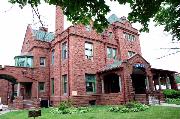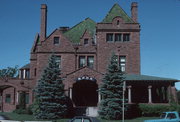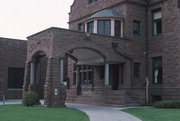Property Record
623 BROADWAY
Architecture and History Inventory
| Historic Name: | Albrecht C. Ringling House |
|---|---|
| Other Name: | BARABOO ELKS LODGE #688 |
| Contributing: | |
| Reference Number: | 71089 |
| Location (Address): | 623 BROADWAY |
|---|---|
| County: | Sauk |
| City: | Baraboo |
| Township/Village: | |
| Unincorporated Community: | |
| Town: | |
| Range: | |
| Direction: | |
| Section: | |
| Quarter Section: | |
| Quarter/Quarter Section: |
| Year Built: | 1906 |
|---|---|
| Additions: | |
| Survey Date: | 1976 |
| Historic Use: | house |
| Architectural Style: | Romanesque Revival |
| Structural System: | |
| Wall Material: | Brownstone |
| Architect: | George Isenberg |
| Other Buildings On Site: | |
| Demolished?: | No |
| Demolished Date: |
| National/State Register Listing Name: | Ringling, Albrecht C., House |
|---|---|
| National Register Listing Date: | 5/17/1976 |
| State Register Listing Date: | 1/1/1989 |
| National Register Multiple Property Name: |
| Additional Information: | A 'site file' exists for this property. It contains additional information such as correspondence, newspaper clippings, or historical information. It is a public record and may be viewed in person at the Wisconsin Historical Society, Division of Historic Preservation. Additional NR information was approved 11/5/1999. The Ringling Brothers circus empire began in 1882, when Albrecht Ringling and four of his brothers organized the Ringling Brothers Classic and Comic Concert Company. It began as a vaudeville act, with Charles playing violin, Alfred performing on the organ and cornet, Al juggling, and John clogging and singing humorous "Dutch" songs. Two years later, they formed the circus. Soon the brothers required fourteen railway cars to transport their equipment and large animals. In 1907, the Ringlings bought the Barnum and Bailey circus, realizing their claim to be the Greatest Show on Earth. As a member of the circus’ "royal family," Ringling built a house fit for a king. George Isenberg, a builder of unusual skill, oversaw construction , but the architect’s name has been lost. The sense of mass, weight, and volume conveyed by the proportions of the building; the play of voids and solids; the expressive use of quarry-faced stone laid in an uncoursed pattern; and the utilization of color instead of applied ornament to enrich the design are noteworthy. The two-and-one-half-story house is constructed of rock-faced brownstone--a reddish-brown sandstone quarried at Port Wing on Lake Superior--and trimmed with smooth-faced brownstone. Hipped, gabled, and pyramidal roofs, clad with green slate and accentuated by gabled and curvilinear parapets, shelter the house’s irregular massing. A squat corner tower rises beside the gabled entry portal. Polished granite columns support the hipped roof of a veranda as it wraps around the tower. Stained art glass fills the oriel window above the porte-cochere, as well as the upper panes of several other windows. Inside, each room on the ground floor is decorated in a different style. The reception room off the oak-finished front hall is ornamented in a lavish Louis XV style, with white-enameled woodwork, silk-covered paneling, mahogany trim, and a Mexican-marble fireplace. The billiard room beyond has a beamed ceiling and a panoramic landscape painted above oak paneling. Across from this chamber is a Gothic-style dining room. The brownstone wing to the west, constructed of stone salvaged from the original carriage house, was added by the Elks Club in 1948. |
|---|---|
| Bibliographic References: | BARABOO DAILY NEWS 12/8/1906 BARABOO NEWS REPUBLIC 10/4/1996. BARABOO News Republic 7/23/1997. BARABOO News Republic 6/5/2002. Buildings of Wisconsin manuscript. |
| Wisconsin Architecture and History Inventory, State Historic Preservation Office, Wisconsin Historical Society, Madison, Wisconsin |





